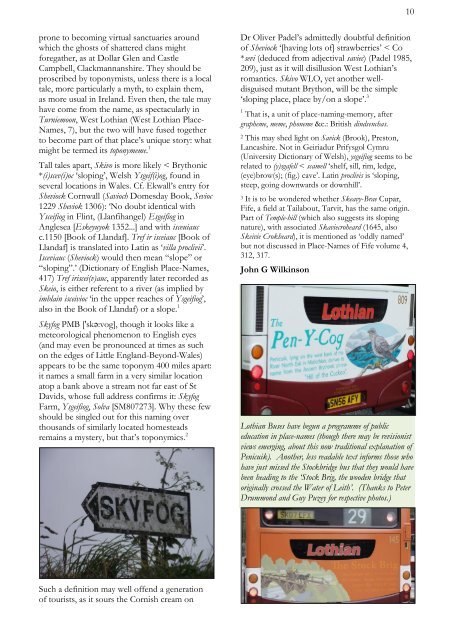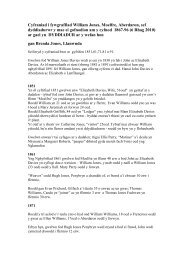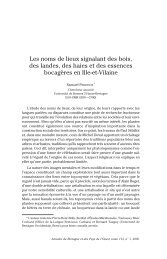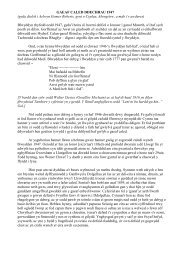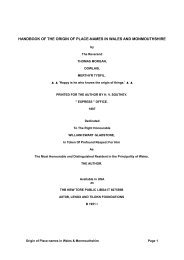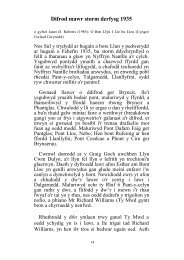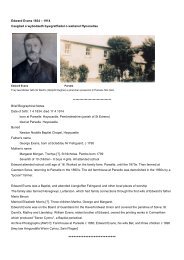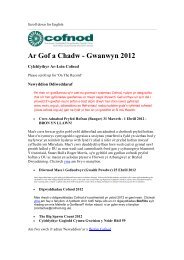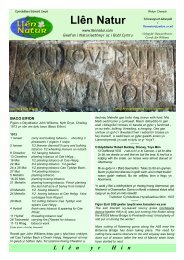new book: 'the place-names of bute'
new book: 'the place-names of bute'
new book: 'the place-names of bute'
Create successful ePaper yourself
Turn your PDF publications into a flip-book with our unique Google optimized e-Paper software.
prone to becoming virtual sanctuaries around<br />
which the ghosts <strong>of</strong> shattered clans might<br />
foregather, as at Dollar Glen and Castle<br />
Campbell, Clackmannanshire. They should be<br />
proscribed by toponymists, unless there is a local<br />
tale, more particularly a myth, to explain them,<br />
as more usual in Ireland. Even then, the tale may<br />
have come from the name, as spectacularly in<br />
Turniemoon, West Lothian (West Lothian Place-<br />
Names, 7), but the two will have fused together<br />
to become part <strong>of</strong> that <strong>place</strong>’s unique story: what<br />
might be termed its toponymeme. 1<br />
Tall tales apart, Skivo is more likely < Brythonic<br />
*(i)scev(i)oc ‘sloping’, Welsh Ysgeif(i)og, found in<br />
several locations in Wales. Cf. Ekwall’s entry for<br />
Sheviock Cornwall (Savioch Domesday Book, Sevioc<br />
1229 Sheviok 1306): ‘No doubt identical with<br />
Ysceifiog in Flint, (Llanfihangel) Esgeifiog in<br />
Anglesea [Eskeyuyok 1352...] and with isceuiauc<br />
c.1150 [Book <strong>of</strong> Llandaf]. Tref ir isceiauc [Book <strong>of</strong><br />
Llandaf] is translated into Latin as ‘villa proclivii’.<br />
Isceviauc (Sheviock) would then mean “slope” or<br />
“sloping”.’ (Dictionary <strong>of</strong> English Place-Names,<br />
417) Tref iriscei(v)auc, apparently later recorded as<br />
Skeio, is either referent to a river (as implied by<br />
imblain isceivioc ‘in the upper reaches <strong>of</strong> Ysgeifiog’,<br />
also in the Book <strong>of</strong> Llandaf) or a slope. 1<br />
Skyfog PMB ['skә:vog], though it looks like a<br />
meteorological phenomenon to English eyes<br />
(and may even be pronounced at times as such<br />
on the edges <strong>of</strong> Little England-Beyond-Wales)<br />
appears to be the same toponym 400 miles apart:<br />
it <strong>names</strong> a small farm in a very similar location<br />
atop a bank above a stream not far east <strong>of</strong> St<br />
Davids, whose full address confirms it: Skyfog<br />
Farm, Ysgeifiog, Solva [SM807273]. Why these few<br />
should be singled out for this naming over<br />
thousands <strong>of</strong> similarly located homesteads<br />
remains a mystery, but that’s toponymics. 2<br />
Such a definition may well <strong>of</strong>fend a generation<br />
<strong>of</strong> tourists, as it sours the Cornish cream on<br />
10<br />
Dr Oliver Padel’s admittedly doubtful definition<br />
<strong>of</strong> Sheviock ‘[having lots <strong>of</strong>] strawberries’ < Co<br />
*sevi (deduced from adjectival saviec) (Padel 1985,<br />
209), just as it will disillusion West Lothian’s<br />
romantics. Skivo WLO, yet another welldisguised<br />
mutant Brython, will be the simple<br />
‘sloping <strong>place</strong>, <strong>place</strong> by/on a slope’. 3<br />
1 That is, a unit <strong>of</strong> <strong>place</strong>-naming-memory, after<br />
grapheme, meme, phoneme &c.: British dindsenchas.<br />
2 This may shed light on Savick (Brook), Preston,<br />
Lancashire. Not in Geiriadur Prifysgol Cymru<br />
(University Dictionary <strong>of</strong> Welsh), ysgeifiog seems to be<br />
related to (y)sgafell < scamell ‘shelf, sill, rim, ledge,<br />
(eye)brow(s); (fig.) cave’. Latin proclivis is ‘sloping,<br />
steep, going downwards or downhill’.<br />
3 It is to be wondered whether Skeavy-Brae Cupar,<br />
Fife, a field at Tailabout, Tarvit, has the same origin.<br />
Part <strong>of</strong> Temple-hill (which also suggests its sloping<br />
nature), with associated Skaviecroheard (1645, also<br />
Skeivie Crokheard), it is mentioned as ‘oddly named’<br />
but not discussed in Place-Names <strong>of</strong> Fife volume 4,<br />
312, 317.<br />
John G Wilkinson<br />
Lothian Buses have begun a programme <strong>of</strong> public<br />
education in <strong>place</strong>-<strong>names</strong> (though there may be revisionist<br />
views emerging, about this now traditional explanation <strong>of</strong><br />
Penicuik). Another, less readable text informs those who<br />
have just missed the Stockbridge bus that they would have<br />
been heading to the ‘Stock Brig, the wooden bridge that<br />
originally crossed the Water <strong>of</strong> Leith’. (Thanks to Peter<br />
Drummond and Guy Puzey for respective photos.)


